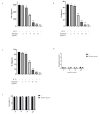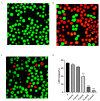Baicalein Ameliorates Streptococcus suis-Induced Infection In Vitro and In Vivo
- PMID: 34072443
- PMCID: PMC8199331
- DOI: 10.3390/ijms22115829
Baicalein Ameliorates Streptococcus suis-Induced Infection In Vitro and In Vivo
Abstract
As an important zoonotic pathogen, Streptococcus suis (S. suis) infection has been reported to be a causative agent for variety of diseases in humans and animals, especially Streptococcal toxic shock-like syndrome (STSLS), which is commonly seen in cases of severe S. suis infection. STSLS is often accompanied by excessive production of inflammatory cytokines, which is the main cause of death. This calls for development of new strategies to avert the damage caused by STSLS. In this study, we found for the first time that Baicalein, combined with ampicillin, effectively improved severe S. suis infection. Further experiments demonstrated that baicalein significantly inhibited the hemolytic activity of SLY by directly binding to SLY and destroying its secondary structure. Cell-based assays revealed that Baicalein did not exert toxic effects and conferred protection in S. suis-infected cells. Interestingly, compared with ampicillin alone, Baicalein combined with ampicillin resulted in a higher survival rate in mice severely infected with S. suis. At the same time, we found that baicalein can be combined with meropenem against MRSA. In conclusion, these results indicate that baicalein has a good application prospect.
Keywords: Streptococcus suis; anti-hemolysin; antibacterial; baicalein; suilysin.
Conflict of interest statement
The authors declare no conflict of interest.
Figures





Similar articles
-
Apigenin and Ampicillin as Combined Strategy to Treat Severe Streptococcus suis Infection.Molecules. 2021 Apr 1;26(7):1980. doi: 10.3390/molecules26071980. Molecules. 2021. PMID: 33915741 Free PMC article.
-
Effective Antibacterial and Antihemolysin Activities of Ellipticine Hydrochloride against Streptococcus suis in a Mouse Model.Appl Environ Microbiol. 2021 Apr 27;87(10):e03165-20. doi: 10.1128/AEM.03165-20. Print 2021 Apr 27. Appl Environ Microbiol. 2021. PMID: 33674433 Free PMC article.
-
Amentoflavone Ameliorates Streptococcus suis-Induced Infection In Vitro and In Vivo.Appl Environ Microbiol. 2018 Nov 30;84(24):e01804-18. doi: 10.1128/AEM.01804-18. Print 2018 Dec 15. Appl Environ Microbiol. 2018. PMID: 30315078 Free PMC article.
-
Antimicrobial resistance and prudent drug use for Streptococcus suis.Anim Health Res Rev. 2013 Jun;14(1):68-77. doi: 10.1017/S1466252313000029. Epub 2013 May 20. Anim Health Res Rev. 2013. PMID: 23683342 Review.
-
Biological activities of suilysin: role in Streptococcus suis pathogenesis.Future Microbiol. 2016 Jul;11:941-54. doi: 10.2217/fmb-2016-0028. Epub 2016 Jun 30. Future Microbiol. 2016. PMID: 27357518 Review.
Cited by
-
Enhancing Agricultural Productivity in Dairy Cow Mastitis Management: Innovations in Non-Antibiotic Treatment Technologies.Vet Sci. 2025 Jul 12;12(7):662. doi: 10.3390/vetsci12070662. Vet Sci. 2025. PMID: 40711322 Free PMC article. Review.
-
Epidemiological and genomic analyses of human isolates of Streptococcus suis between 2005 and 2021 in Shenzhen, China.Front Microbiol. 2023 Mar 27;14:1118056. doi: 10.3389/fmicb.2023.1118056. eCollection 2023. Front Microbiol. 2023. PMID: 37113229 Free PMC article.
-
Research progress on the regulatory and pharmacological mechanism of chemical components of Dendrobium.Heliyon. 2024 Sep 7;10(18):e37541. doi: 10.1016/j.heliyon.2024.e37541. eCollection 2024 Sep 30. Heliyon. 2024. PMID: 39328574 Free PMC article. Review.
-
Antibacterial activity of baicalein against Aeromonas hydrophila: in vitro and in vivo evaluation.Front Microbiol. 2025 Jul 14;16:1615029. doi: 10.3389/fmicb.2025.1615029. eCollection 2025. Front Microbiol. 2025. PMID: 40727559 Free PMC article.
-
Baicalein combined with azoles against fungi in vitro.Front Microbiol. 2025 Mar 13;16:1537229. doi: 10.3389/fmicb.2025.1537229. eCollection 2025. Front Microbiol. 2025. PMID: 40182279 Free PMC article.
References
-
- Goyette-Desjardins G., Auger J.P., Xu J., Segura M., Gottschalk M. Streptococcus suis, an important pig pathogen and emerging zoonotic agent-an update on the worldwide distribution based on serotyping and sequence typing. Emerg. Microbes Infect. 2014;3:e45. doi: 10.1038/emi.2014.45. - DOI - PMC - PubMed
MeSH terms
Substances
Grants and funding
LinkOut - more resources
Full Text Sources
Medical
Research Materials

